Early ripening and very popular among summer residents, Sora radish
The history of the appearance of radishes goes back to the Middle Ages, but Peter I brought them to Russia at the end of the 17th century. Today, radishes are an ingredient in many national dishes of France, Mexicans make original figurines and entire sculptures from it, but we Russians cannot imagine the main thing of summer dish - okroshka - without her participation.
This root vegetable is healthy, early ripening, easy to care for, which is why summer residents love it. The variety of tastes has given rise to variety of varieties. The radish hybrid Sora f1 embodies the desires of all gardeners. Why is it so popular? Let’s look at it further.
What kind of radish is this
Radish Sora f1 is a Dutch culture created at the end of the twentieth century. Since 2001, the hybrid began to successfully take root in Russia and entered the state register of breeding achievements. Recommended for cultivation in greenhouse conditions and open ground.
Reference. F1 hybrids are crops obtained artificially as a result of crossing different varieties. Their main difference from pure varieties is that seeds from the harvest are not suitable for subsequent plantings.
Characteristics and description of the hybrid
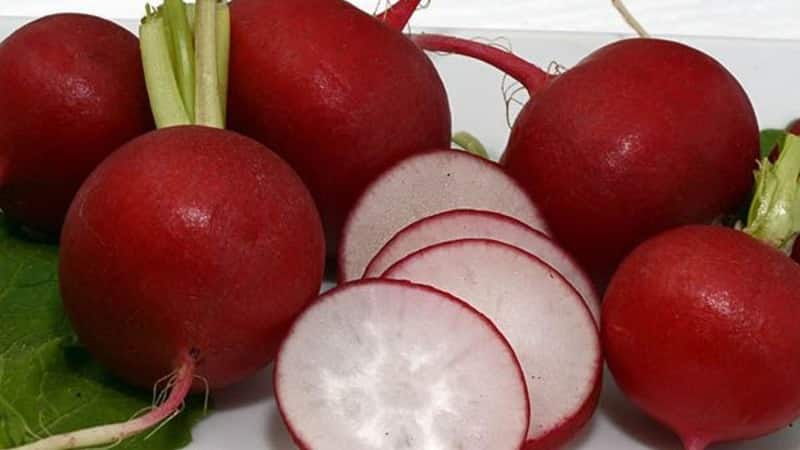
Radish Sora is an early ripening plant, 23-26 days pass from emergence to full ripening. Not afraid of cold weather. The leaves grow straight, forming a compact bush.
Productivity is high, from 1 sq. m harvest 1.5-1.8 kg of fruit. The crop is planted from early spring to late autumn, which makes it possible to collect several full harvests per season.
The plant is resistant to cruciferous (cabbage) diseases such as downy mildew and powdery mildew. Also, seedlings are not afraid of attacks from many insects.
Radishes are grown not only for personal use, but also on an industrial scale.
Description of fruits
The average weight of one radish is 15-20 g, but with good care it gains weight up to 30 g. The shape is round, the color is bright scarlet. The taste is slightly spicy - a piquant addition to bland vegetables. The pulp is juicy, without voids.
The ability to retain its presentation and taste for a long time allows the hybrid to be bred on an industrial scale for trade.
The photo shows the Sora radish.
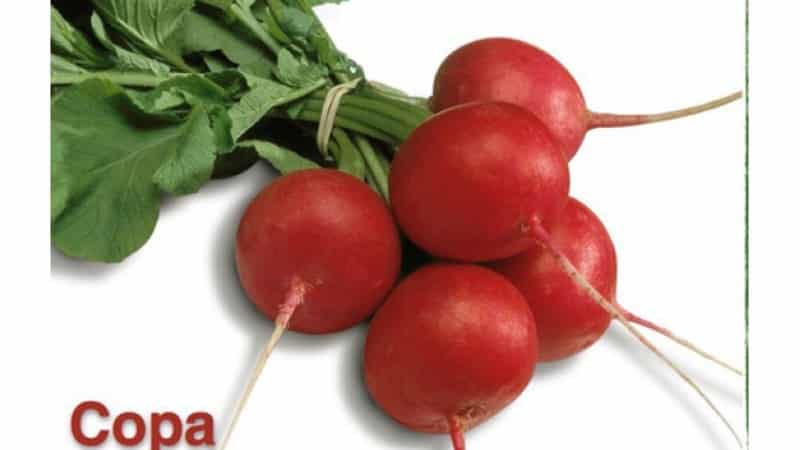
Growing Sora radish
The purchased radish seeds are already ready for sowing. They do not need disinfection, since the manufacturer carries out this procedure independently, additionally saturating the seed with nutrients.
Since the crop is resistant to low temperatures, it is sown in the greenhouse from the beginning of spring. Experienced farmers sow grains several times a season, until mid-autumn.
The soil for radishes is light and fertile with neutral acidity. Litmus paper will help determine its level. A little earth is dissolved in a glass of water and the indicator is lowered into it.
If its color changes to red, then the permissible level of acidity in the soil is exceeded and dolomite flour or slaked lime should be added to it. If the color of the indicator remains unchanged, then the acidity in the soil is not exceeded.
Reference. Dolomite flour, unlike slaked lime, begins to act later, but it is safer for the environment.
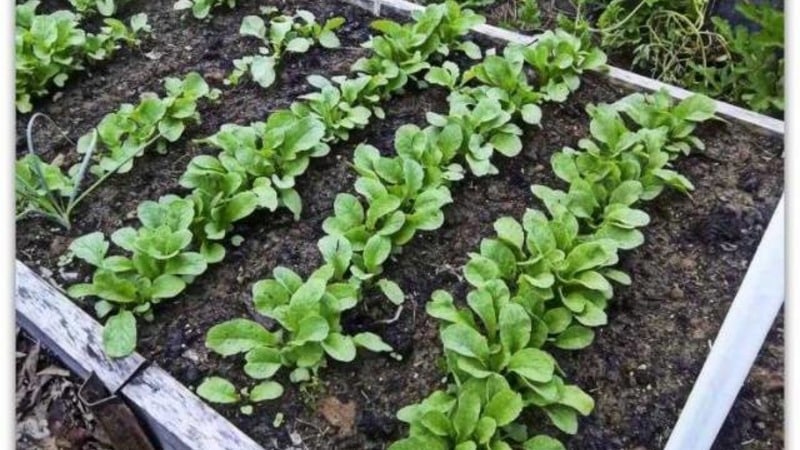
Landing
The seed material is buried 1-1.5 cm, but not deeper than 2 cm, otherwise the fruits will not have a round, but an elongated shape.
It is not recommended to apply fertilizers to the soil before sowing; it is better to do this long before planting. To ensure soil fertility, it is saturated with peat or humus.
Planted in two ways: tape and continuous. In the first case, two rows are made, the distance between which is 5 cm. The distance between the holes is 4-5 cm. The next tape (that is, two more rows) is placed at a distance of 15 cm. With this method of sowing, it is convenient to weed the beds.
The continuous sowing pattern is 5x5 cm. One grain is placed in each hole, since the germination rate of Sora radish is high, almost 100%. With frequent sowing, the plantings may become denser, which will lead to a decrease in yield.
After sowing, moisten the soil and wait for seedlings to emerge. Typically, grains germinate on the fifth day, but cold or, conversely, hot weather can delay germination by several days.
Care
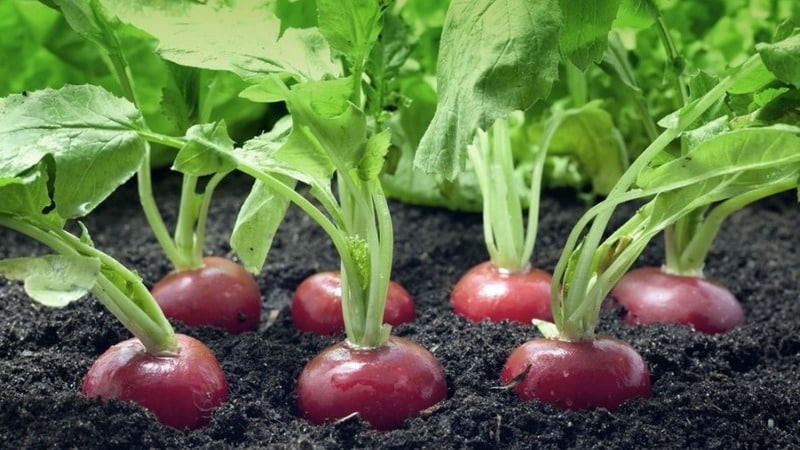
When caring for a variety from the cruciferous family, it is important to maintain an even level of humidity. Over-wetting the beds will lead to cracking of the fruits. Lack of moisture will also have a negative impact.
After watering, the soil is loosened to improve air permeability and protect the beds from the invasion of ground pests.
The crop does not need fertilizing due to the short growing season. It is quite enough for the fertilizers that were applied before sowing. The crop will give a good harvest in the soil where a full complex of mineral fertilizers has been added, with a predominant content of phosphorus and potassium, and humus.
Reference. Organic fertilizers are not used when growing radishes.
Disease and pest control
If crop rotation rules are not followed, the likelihood of crop disease increases. This is due to a lack of nutrients that are necessary for full development and healthy immunity.. One of these diseases is clubroot. It is characterized by swelling on the roots, as a result of which the plant withers and dies.
Clubroot is not easy to control, so it is important to protect radishes from this disease. To do this, they weed the beds and do not plant seeds where plants from the cruciferous family previously grew. Three days before sowing, a little wood ash is added to the holes as a preventive measure.
Among the pests, cruciferous flea beetles cause irreparable damage to plantings. They are dangerous in the first two weeks after emergence. These are small black jumping beetles. They eat young leaves by gnawing holes in them. That is why it is important to protect plantings after germination.
Any non-woven material that freely allows air and light to pass through will do. Cruciferous flea beetles are also afraid of the smell of garlic, dill, marigolds and calendula. Planted fragrant herbs next to the radishes will reliably protect the beds from the invasion of uninvited guests.
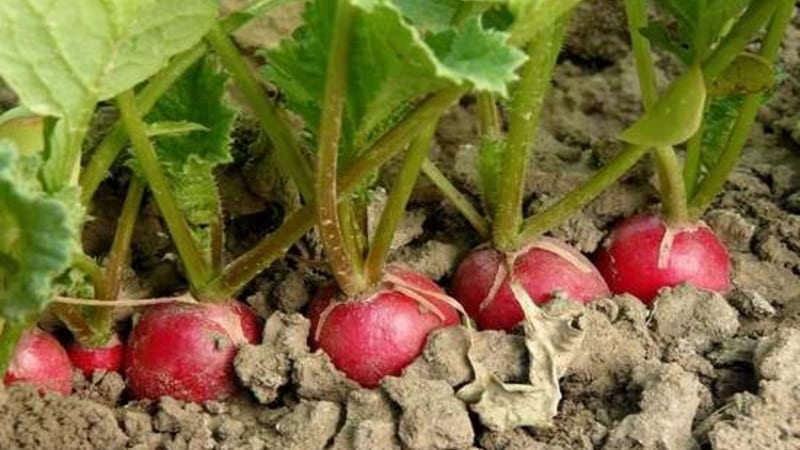
Harvesting and application
Three weeks after germination, harvesting begins. The root crop ripens together, the fruits are almost the same size and even.
Large quantities of radishes are stored in wooden boxes with air holes.. To prevent the fruits from touching each other, a sheet of cardboard is placed between the layers. The room temperature should be no more than +6°C. In such conditions, vegetables save taste and shape for a month.
The fruits tolerate transportation well. In the kitchen, the root vegetable is suitable for fresh salads, combines harmoniously with other vegetables, and serves as a decoration for main courses.
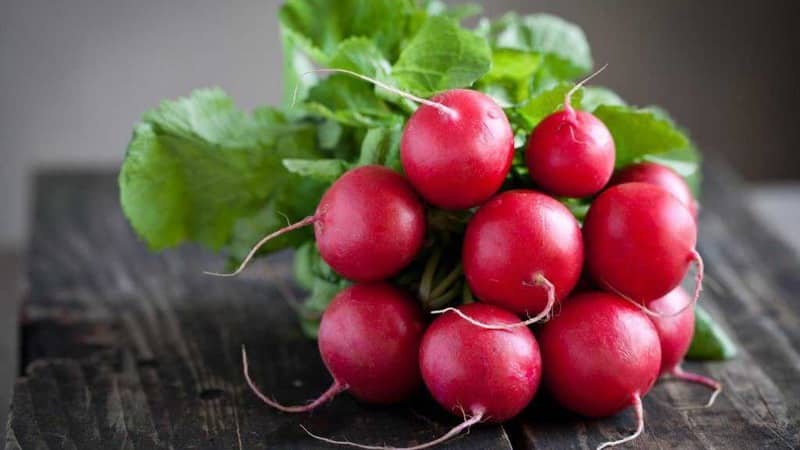
Features of growing in a greenhouse
Closed structures must be ventilated every day so that temperature and humidity do not exceed normal limits (60-70%, up to 85%). Increased humidity increases the risk of developing fungal infections. Fresh air also destroys the habitat of many greenhouse pests.
Usually in the greenhouse the temperature is kept minimal for the first three weeks from germination, no more than +10°C. Then it is raised to +20°C and kept at this level until harvest. This regime is favorable for healthy growth of the crop.
Watering throughout the entire growing season is kept moderate, without flooding the beds. At the same time, care is taken to ensure that there is no moisture deficiency.
The top layer of soil is changed every year. Many larvae and bacterial spores successfully overwinter in the ground, and after planting in greenhouses, pathogenic microorganisms cause serious harm. If there is no possibility of replacing the soil, then the soil is dug up with the addition of a full complex of mineral substances and spilled with a hot solution of dark potassium permanganate to destroy fungal spores.
In the open ground
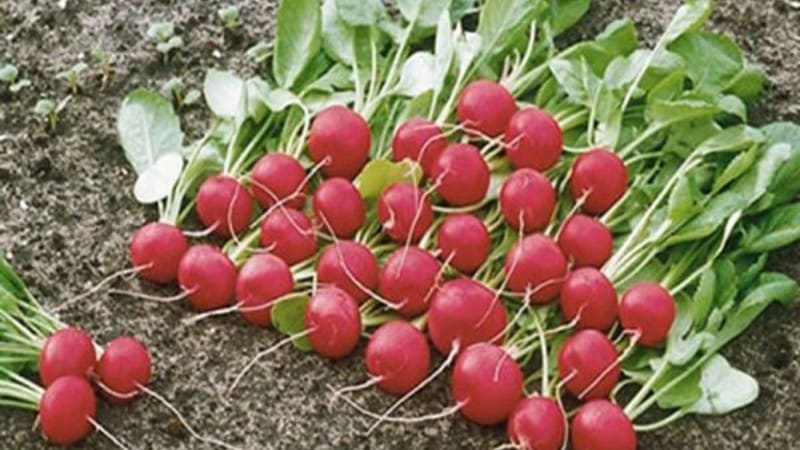
In open ground with long daylight hours and bright sun, it is important to shade the seedlings. Radishes do not like direct sunlight.. This negatively affects the developing fruits, which become smaller.
Densified plantings lead to decreased yields. Don't forget about thinning. The density of seedlings can also lead to the spread of fungal diseases or the rapid proliferation of pests.
Spraying plantings with an infusion of onion peels will repel many insects from the beds and prevent the spread of many diseases - for example, bacteriosis.
Unlike other varieties, Sora is unique in that it practically does not produce arrows.This feature attracts most gardeners.
Reference. When bolting (flowering), radishes do not form a root crop.
The reasons for shooting are different:
- irregular watering;
- intense and prolonged heat or the same cold;
- nitrogen oversaturation;
- dense plantings.
According to the rules of crop rotation, radishes should not be planted more than three times in the same place. The best predecessors are crops from the nightshade family (eggplant, tomatoes, potatoes), legumes and melons. But after crops from its family, the cruciferous family, it is not worth planting radishes.
Advantages and disadvantages
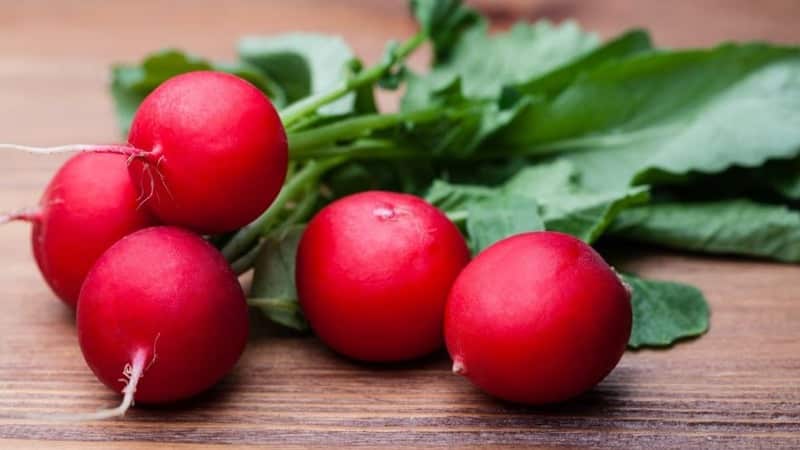
Hybrid Sora f1 has a number of advantages:
- early ripening;
- easy care;
- adaptation to weather conditions;
- disease resistance;
- does not release the shooter;
- excellent taste;
- marketable condition;
- long transportation;
- long-term storage.
Disadvantages include the inability to independently collect seeds and the effect of watering on fruit formation.
Farmer reviews
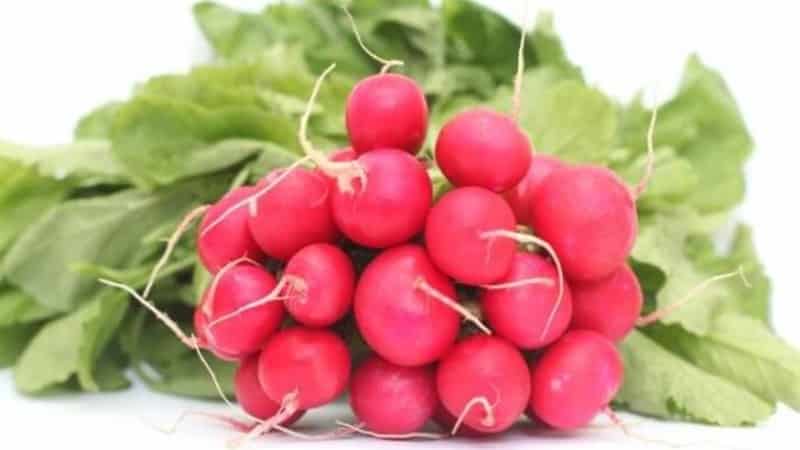
Reviews about the root vegetable are mostly positive. Those who planted the hybrid on their plots do not want to part with it.
Larisa, Taganrog: «I read about the Sora hybrid and its resistance to flowering and decided to try it. The shoots turned out to be friendly, the fruits ripened quickly. The taste is beyond praise - all the radishes are juicy, crispy, and moderately spicy. The appearance is smooth and beautiful. The radish did not hurt. I have never grown a better variety!”
Tatiana, Astrakhan: “I really love radishes, but I couldn’t grow them myself for a long time. I quickly became friends with the hybrid Sora; in the first year he pleased me with an excellent harvest. It makes very tasty salads, and it’s delicious on its own. Very pleased with the root vegetable.I will definitely plant it next year.”
Conclusion
Radish Sora has captivated Russians with its numerous advantages: simple agricultural technology, high yield (1.5 kg per 1 sq. m) and strong immunity. The hybrid quickly adapts to weather conditions and does not shoot. The crop is bred not only for personal purposes, but also on an industrial scale.